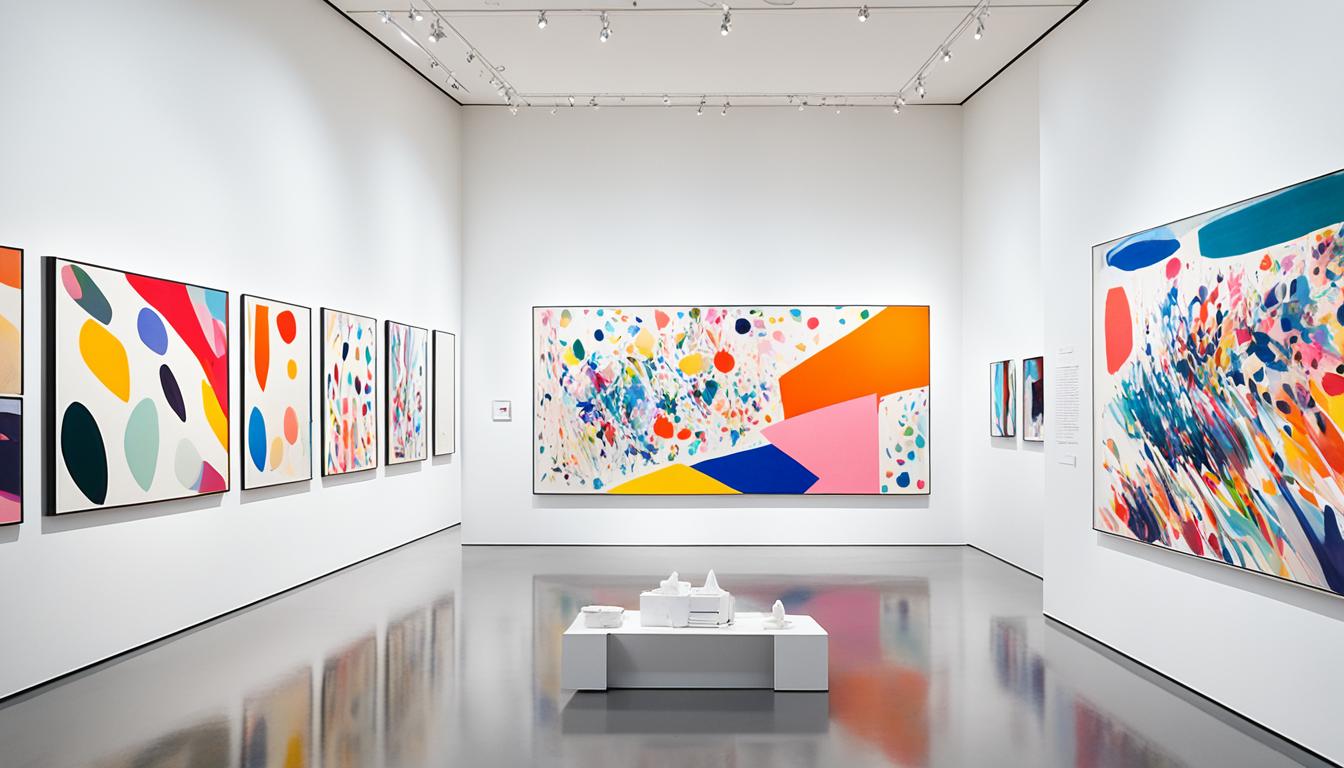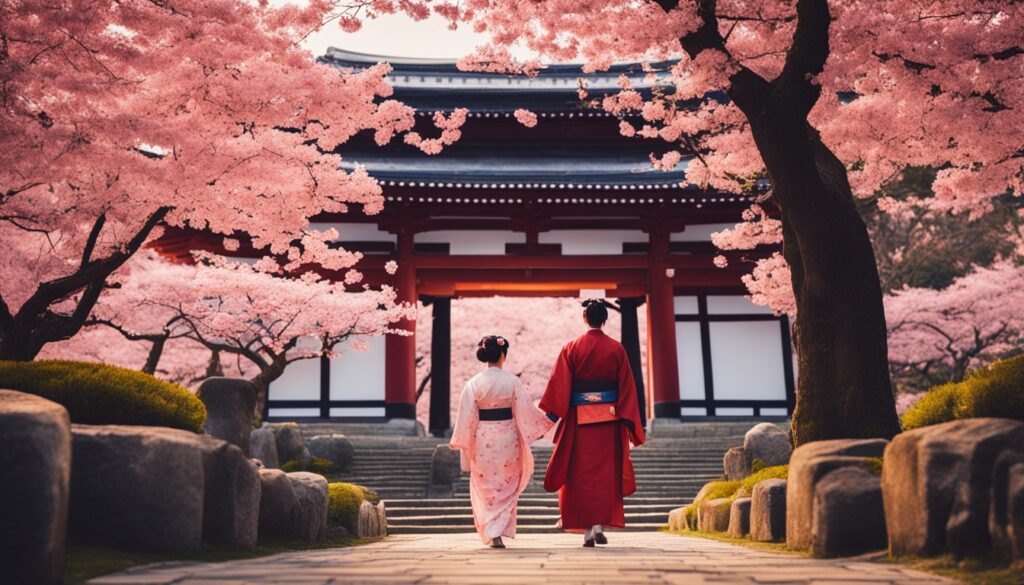Japan is a dream come true for those who love culture and history. It has over 5,600 museums against a beautiful backdrop. About one-fifth of these are art museums, showcasing Japan’s creativity through time. Cities like Tokyo and Kyoto are full of museums with both old and new art pieces. Sophie Richard’s book “The Art Lover’s Guide to Japanese Museums” from Paul Holberton Publishing is a must-read. It talks about 50 art places you shouldn’t miss, covering Japan’s main regions.
In Japan, museums take very good care of art and often change their displays. This keeps the art safe and lets you see new pieces every time you visit. You can also see art blended with beautiful gardens and historical sites. Places like Sankeien Garden in Yokohama and the Hoki Museum in Chiba do this perfectly. They mix nature, history, and art for an amazing experience.
Key Takeaways
- Japan’s rich tapestry of culture and history is epitomized in its 5,600+ museums.
- Travelers can explore a curated list of top art museums, handpicked for a diverse and enriching experience.
- Museums in Japan are dynamic, with frequently rotating collections that offer visitors a fresh perspective upon each visit.
- The integration of art within natural and historical settings, like Sankeien Garden and Enoura Observatory, provides an immersive cultural experience.
- The strategic division of museums into the geographical regions of Japan aids in planning a cohesive and comprehensive travel itinerary.
Exploring the Cultural Tapestry of Japan Museums, Galleries, and Exhibits
The landscape of Japanese Museums and Galleries is rich like a silk kimono. It mixes Art and History into a cultural tapestry. These places show everything from ancient textiles to modern art. They let us see Japan’s culture through different stories and objects.
In Oxford’s Ashmolean museum, you’ll find textiles from the Meiji era. The Tokyo Metropolitan Teien Art Museum, finished in 1933, does something similar. Each exhibit lets us appreciate Japan’s long heritage. These textiles were once in 19th-century homes and given as gifts. They show a Japan loved by Westerners for its natural beauty.
Art historians get excited about seeing rare pieces not often sold. A museum in Kyoto has some of these treasures. The Teien Art Museum has been open since 1983 and is a Tangible Cultural Property. It respects both old and new art. Even as it looks forward to new shows, it remembers its artistic history.
Looking at upcoming shows, the San Francisco Fine Arts Museums have a great lineup for 2024. They’ll feature historic and modern artists, with a focus on women like Leilah Babirye and Mary Cassatt. Their art blends personal stories with cultural discussions, across time and place.
| Exhibition | Venue | Theme | Dates |
|---|---|---|---|
| We Have a History | de Young | Gendered Sculptures | June 22, 2024 – June 22, 2025 |
| Mary Cassatt: Modernist Pioneer | Legion of Honor | Modernist Works | October 5, 2024 – January 26, 2025 |
| Art Deco and Modernism | de Young | Works by Tamara de Lempicka | October 12, 2024 – February 9, 2025 |
| LEXICON | de Young | Mixed-Media Works | November 16, 2024 – June 29, 2025 |
These Exhibits showcase the artists’ paths and the stories of where they are displayed. They add to the quilt of Japanese and global art history. By visiting these places, we dive deeper into the art and culture that connect us all.
Unlocking the Mysteries of Traditional Japanese Art
Exploring Traditional Japanese Art opens a window to Japan’s rich history and culture. The country’s unique heritage attracts art lovers and travelers. They discover its artistic wonders, held in special places of history and creativity.
The Gallery of Horyu-ji Treasures stands out as a keeper of national treasures from the ancient Horyu-ji Temple. Its extensive collection sheds light on Japan’s spiritual and art historical roots. Every piece in the gallery has a deep story, showing Japan’s cultural growth.
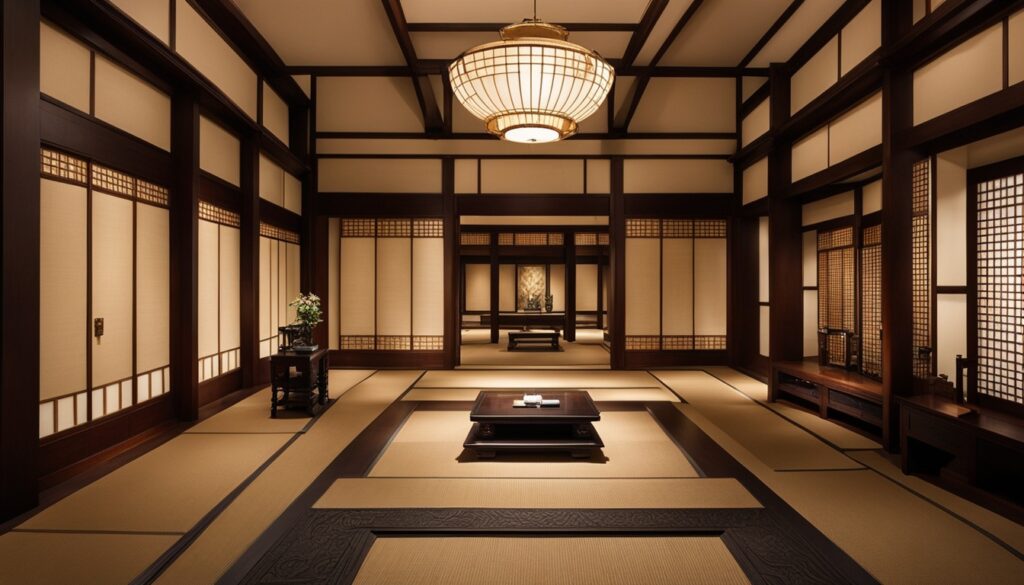
The Japan Folk Crafts Museum
The journey through Japanese culture leads to The Japan Folk Crafts Museum. At the heart of the Mingei movement, this museum celebrates Japanese culture’s essence through crafted objects. Each creation embodies the belief in beauty’s union with function, showcasing traditional craftsmanship passed down through generations.
Meiji Memorial Picture Gallery
The Meiji Memorial Picture Gallery remembers Japan’s era of change and modernization under Emperor Meiji. This gallery honors historic figures and illustrates Japan’s opening to the world. It stands as an essential cultural site.
These respected places preserve Japan’s revered art forms and promote understanding of its traditional art and culture. They connect Japan’s historic past with today, ensuring its art legacy continues to inspire.
Immersive Experience at Tokyo’s Contemporary Art Spaces
Tokyo is a city known for its continuous innovation and rich culture. It has some of the most lively contemporary art scenes in the world. For both art lovers and casual visitors, Tokyo’s art scene offers deep and engaging experiences. These experiences highlight cutting-edge art and provide peaceful places for art reflection.
Watari Museum of Contemporary Art
The Watari Museum of Contemporary Art is a hub of artistic innovation. It is located in the busy streets of Tokyo. This gallery draws in the imagination with its pioneering exhibitions. These exhibitions challenge and excite those who visit.
Musee Tomo
In contrast, Musee Tomo offers a peaceful space for exploration. It specializes in the art of porcelain making. This museum connects the past and present. It provides a calm space to enjoy the delicate beauty of Japanese porcelain. This art form’s charm is reimagined in today’s cultural scene.
Hara Museum and Hara Museum ARC
The Hara Museum and its counterpart, Hara Museum ARC, provide a full experience in international contemporary art. These two places are known for showcasing groundbreaking art. They are set against Tokyo’s magical setting. This setting offers both a city and countryside art adventure.
| Museum | Opening Year | Notable Features | Exhibition Highlights |
|---|---|---|---|
| Watari Museum of Contemporary Art | 1990 | Modern Works, Avant-garde Exhibitions | Design-oriented collections, various contemporary artists |
| Musee Tomo | 2003 | Porcelain Art, Tranquil Setting | Japanese Kyo-Satsuma wares, works by Living National Treasures |
| Hara Museum | 1979 | International Contemporary Art | Modern Japanese and international artists, interactive installations |
Each contemporary art space in Tokyo gives you a unique art journey. Art is not just seen but deeply felt. These places, from pioneers like the Watari Museum to sanctuaries like Musee Tomo and hybrids like the Hara Museums, show Japan’s deep love for art. They are the heart of Contemporary Art Spaces in Tokyo.
The Fusion of Fashion and Art at Bunka Gakuen Costume Museum
In Tokyo, the Bunka Gakuen Costume Museum beautifully shows how fashion and art come together. It lets visitors see how clothes and design play a big part in Japanese culture. They explore the link between old textile ways and new fashion trends.
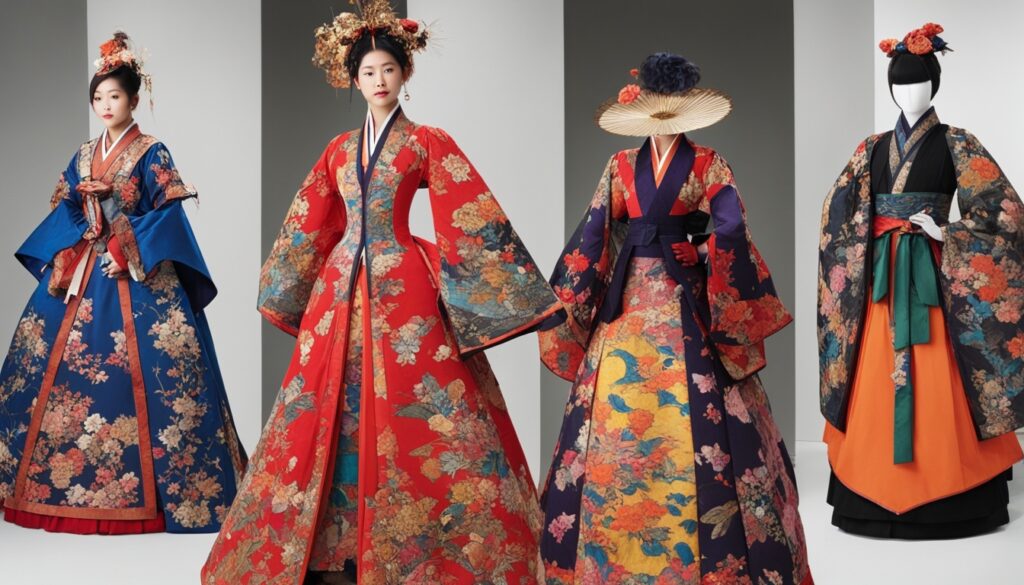
The museum takes you on a journey of style from the Meiji era to today. It celebrates fashion as more than just clothes. It sees fashion as a key cultural piece that mirrors society’s changes and creative swings.
| Period | Artistic Influence | Cultural Significance |
|---|---|---|
| Meiji and Taisho Era | Fusion of traditional motifs with Western styles | Representative of Japan’s modernization and international assimilation |
| Showa Era | Emergence of avant-garde and contemporary designs | Expression of post-war rejuvenation and individualistic fashion trends |
| Heisei to Reiwa Era | Confluence of global fashion influences with traditional craftsmanship | Emblematic of cultural diversity and the globalization of Japanese aesthetics |
The Bunka Gakuen Costume Museum is more than a place for old clothes. It connects fashion with art. The museum talks with Tokyo’s current fashion world. It helps teach and inspire new artists and designers, making a mark on the global stage.
“Fashion is not something that exists in dresses only. Fashion is in the sky, in the street, fashion has to do with ideas, the way we live, what is happening.” — Coco Chanel
Here, each piece tells a unique story of skill and style. Bunka Gakuen Costume Museum doesn’t just display clothes. It shows how fashion shapes culture and shares Japan’s rich history.
Historical Narratives at the Edo-Tokyo and Kyu Asakura House
The Edo-Tokyo Museum and the Kyu Asakura House are key in keeping Tokyo’s history alive. They share stories that helped shape Japanese culture and history. People who love history find these places enlightening.
Edo-Tokyo Museum
The Edo-Tokyo Museum takes visitors on a journey through Tokyo’s past, known then as Edo. It showcases the city’s growth from its early days to now. The exhibits show how Tokyo’s culture and lifestyle changed over time.
Kyu Asakura House
The Kyu Asakura House, on the other hand, gives a peek into the Taisho era. It highlights upper-middle-class life in Tokyo back then. This house shows the beauty of Japanese tradition and its preservation.
Together, these places tell the complex story of Japan’s past. They focus on truth and education. Anyone wanting to understand Japan’s culture should visit them.
The Imperial Collections: A Window to Japan’s Royal History
When you visit The Museum of the Imperial Collections in Tokyo, you feel the greatness of Japan’s royal past. This museum is in the Imperial Palace’s East Gardens. It showcases Japan’s cultural heritage that spans centuries. You get a close look at exhibits that show Japanese culture through time.
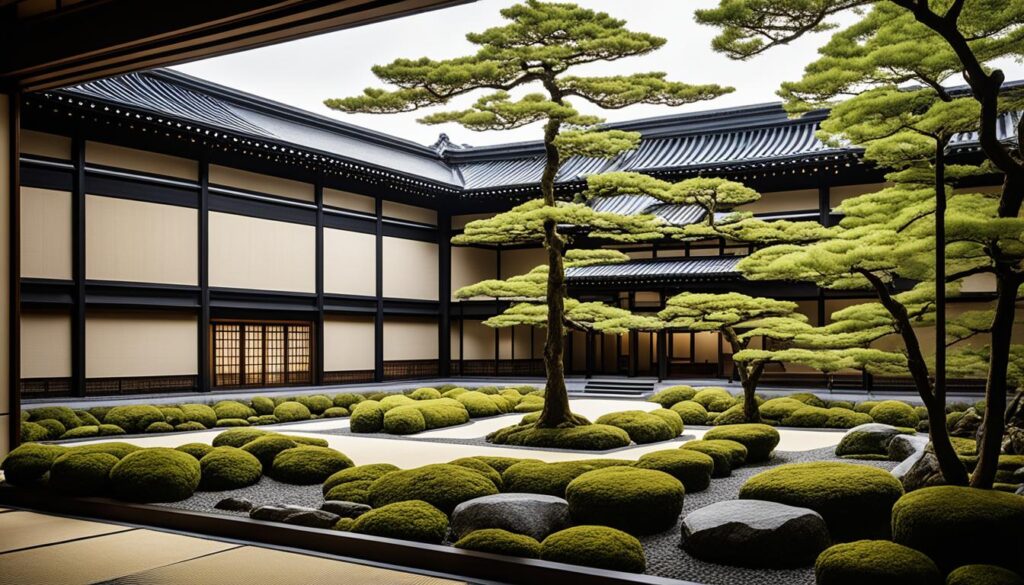
The museum looks after artifacts that share stories of the royal family’s dedication to the arts. Royals have helped preserve and shape Japan’s culture, making their collections key to understanding this rich heritage. Each piece, from scrolls to garments, shows what the imperial court liked and valued.
The Imperial Collections show how culture can stand the test of time. They mark Tokyo’s role in guarding arts and exhibits. The collections show key moments, like going from old papermaking to modern methods introduced in 1872.
The Museum holds treasures from ancient Japan, like tea ceremony practices and ink paintings influenced by Zen Buddhism. Seeing these pieces lets us appreciate Japan’s past. Highlights include burial artifacts from the Kofun period and samurai gear, showing both power and art.
The Tokyo National Museum celebrates over 150 years by showing these “Future National Treasures”. The Museum of the Imperial Collections shares Japan’s royal history and strengthens Tokyo’s cultural ties. It adds royal charm and beauty that continues to captivate and educate.
Venturing through Kyoto: A Haven of Artistic Heritage
Walking through Kyoto’s cobbled streets, you feel its calm vibe. You’ll see how it deeply connects with traditional Japanese art and culture. Not just an old capital, Kyoto preserves Japan’s art legacy. Two museums, the Kawai Kanjiro Memorial Museum and the Kiyomizu Sannenzaka Museum, are key to this spirit.
Kawai Kanjiro Memorial Museum
In Kyoto’s heart, the Kawai Kanjiro Memorial Museum celebrates a famous potter, Kawai Kanjiro. It welcomes visitors to see Kanjiro’s home and studio. This reveals the life of a leading Mingei (folk craft) movement artist.
The museum displays his work, like ceramics and woodcarvings. These pieces show a lifetime spent mastering art in Kyoto’s cultural scene.
Kiyomizu Sannenzaka Museum
The Kiyomizu Sannenzaka Museum is near the famed Kiyomizu-dera Temple. It beautifully fits into the historic area. The museum praises pottery and ceramics, showcasing the unique Kiyomizu-yaki style.
It tells the story of Kyoto’s artistic achievements over time. This is more than a museum; it’s a journey into art history.
These museums are more than buildings; they’re storytellers of art and culture. Visiting them offers a deep dive into Kyoto’s soul. You connect with past and present art worlds. The beauty of Kyoto’s art stays with you, a sign of Japan’s lasting art and culture.
The Allure of Hakone’s Open-Air & Pola Museums of Art
In Hakone, art lovers find a unique mix of nature and art. The Open-Air Museum and Pola Museum of Art blend nature’s beauty with amazing art. This mix brings new life to contemporary and historic art.
The Open-Air Museum sits in a beautiful park of 70,000 square meters. It’s a cultural spot with nearly 120 sculptures by modern and classic artists. This place where art meets nature is amazing.
The Pola Museum, set in a green forest, shows an impressive art collection. With 9,500 pieces, it covers everything from European paintings to Asian ceramics. It offers a journey through art history.
Experience a journey where art, nature, and design blend, creating more than just a museum visit.
Notable Exhibitions Across Hakone’s Museums:
| Museum | Exhibits | Notable Collections |
|---|---|---|
| Venetian Glass Museum | 100 pieces of Venetian glass | 15th to 19th centuries |
| Narukawa Art Museum | Over 4,000 works | Works by Kyujin Yamamoto and Ikuo Hirayama |
| Lalique Museum | Over 1,500 pieces | Jewelry by René Lalique |
| Okada Museum of Art | About 350 items | East Asian ceramics & modern art |
The Pola Museum of Art is a top spot for art fans, blending beautiful views with a stunning glass front. Meanwhile, the Hakone Open-Air Museum lets you explore art amidst Mount Hakone’s beauty.
- See the play of light on glass at the Venetian Glass Museum,
- Enjoy Japanese views at the Narukawa Art Museum,
- Marvel at René Lalique’s timeless works at the Lalique Museum,
- Check out East Asian ceramics at the Okada Museum of Art.
Hakone offers a mix of beautiful views and modern art. It’s where culture and avant-garde art meet, ensuring a visit you’ll remember.
Celebrating Craftsmanship at The Japan Folk Crafts Museum’s Mingei Legacy
In Tokyo, the Japan Folk Crafts Museum celebrates the Mingei Legacy. It highlights the beauty of handmade objects. Founded in 1936 by Soetsu Yanagi, it has inspired many, including fashion icon Issey Miyake. Dignitaries like U.S. ambassador Howard Baker and senator Nancy Kassebaum Baker have also admired its collections.
This museum showcases the culture and skill of artisans. One example is the “Sacred Masks of Kyushu” exhibit, which was on display until Dec. 20. The Mingeikan, or museum, not only keeps the Mingei movement alive. It also connects it with global arts like the British Arts and Crafts Movement.
| Event | Date | Impact |
|---|---|---|
| Vienna Secession Formation | April 1897 | Inspired global Arts and Crafts movements |
| Wiener Werkstätte Establishment | 1902 | Innovated art integration into everyday life |
| Deutscher Werkbund Inception | 1907 | Enhanced craftsmanship in domestic products |
| Mingei Movement Official Establishment | 1926 | Reinvigorated Japanese folk crafts |
| Japan Folk Crafts Museum Opening | 1936 | Embarked on cultural preservation |
The Mingei philosophy is at the heart of the museum’s mission. It aligns with European efforts to celebrate handmade goods. This movement’s impact is seen worldwide, even in New York’s Museum of Arts and Design. The foundation of Mingei is in Japanese pottery and techniques like Iro-e and Zōgan. Types of ware, such as Kutani and Tsuboya, showcase the movement’s diversity.
“The beauty of people’s crafts lies in the love they were born out of.” – Soetsu Yanagi
The museum honors the art of yūki-tsumugi, recognized by UNESCO, and master crafters at the Japan Traditional Kōgei Exhibition. It stands as a tribute to Japanese cultural heritage. It’s a place where the talent and passion of artisans continue to inspire. Here, the beauty of handmade objects is celebrated with each exhibit.
Art and Nature Intertwined: The Outdoor Splendors of Hakone and Naoshima
The blend of Art and Nature shines through in two remarkable spots in Japan. Hakone Open-Air Museum invites guests to enjoy nature and thought-provoking exhibits. Benesse Art Site Naoshima combines clever design with nature, ideal for reflection and enjoying art.
The Hakone Open-Air Museum
Hakone Open-Air Museum, Japan’s first, beautifully combines art with the outdoors. It spans several acres, showcasing pieces by both Japanese and global artists. These works blend well with the nature around them.
Benesse Art Site Naoshima
Benesse Art Site Naoshima is a place where art meets nature. On Naoshima island, it features art pieces and buildings. They all look over the peaceful Seto Inland Sea.
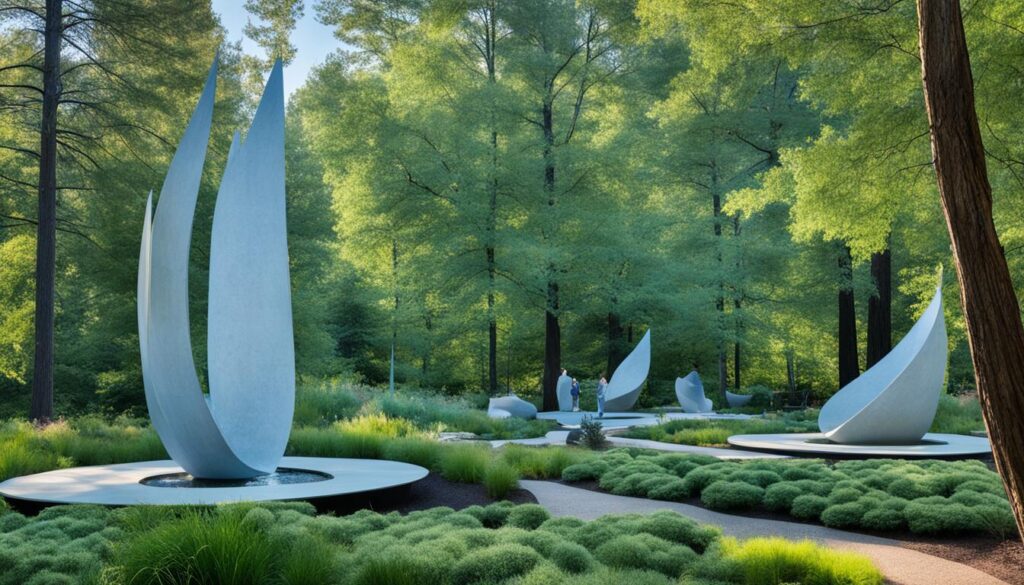
These places show how important surroundings are for enjoying art. They argue that nature can enhance art just like any museum. To really get it, let’s compare them to other famous outdoor art places worldwide.
| Location | Size | Experiences Offered |
|---|---|---|
| Yorkshire Sculpture Park, UK | 500 acres | Rolling hills, woodlands, lakes with traditional and modern sculptures |
| Frederik Meijer Gardens & Sculpture Park, USA | 158 acres | Lush gardens, spectacular sculptures, conservatory, and themed exhibitions |
| Hakone Open-Air Museum, Japan | Extensive | Diverse collection of sculptures, picturesque views, and hot spring footbath |
If you want to see more of Japan’s art inspired by nature, check out the 2024/2025/2026 CHERRY BLOSSOM TOURS. These tours feature Japan’s top gardens and museums, blending horticulture and art.
The Hakone Open-Air Museum and Benesse Art Site Naoshima mix lush greenery with culture. Both places prove the strong link between art and the natural world. They keep wowing guests, celebrating the beauty of art and nature.
Insights into the Tea Ceremony at Kyoto’s Raku Museum
The Raku Museum in Kyoto showcases the Tea Ceremony, a key part of Traditional Japanese Art. It has been around for more than 450 years. The museum honors the art and history of Raku ware. This craft has been shaped by the Raku family for 15 generations.
| Aspect | Details |
|---|---|
| Workshop Legacy | 15 generations of Raku ware potters |
| Current Craftsperson | Raku Kichizaemon, generation XV |
| Collections | Approx. 1,100 works including tea ceremony utensils |
| Exhibit Rotation | Quarterly change to display |
| Admission Fees | Adults: 800 yen, Students: 600 yen, Children: 300 yen |
| Opening Hours | 10 a.m. – 4:30 p.m. |
At the Raku Museum, making tea bowls is key. Raku Kichizaemon currently leads this effort. His work honors the tradition of Raku ware. This tradition tightly links the Raku family to the tea ceremony, showing Japanese aesthetics.
Robert Yellin’s Yakimono Gallery in Kyoto is another must-visit for ceramics lovers. It offers a wide range of Japanese ceramics. These pieces reflect Japan’s history and the shifts in society and the ceramic industry. This history spans from the ancient Jomon period to today’s challenges for artisans.
- Decline in sales for high-grade ceramics post economic “bubble years”
- Efforts to modernize and preserve traditional crafts, including setting up learning centers for art transmission
- Global recognition of traditional arts such as Rimpa and its relevance today
- Continued cultural and economic importance of pottery and traditional crafts in Kyoto
In a world that often wants quick results, places like the Raku Museum are vital. They protect ancient practices. The museum’s exhibits and programs help keep Japan’s culture alive. They also link us to a deep history told through pottery.
Learning about these traditional arts shows us their past and talks about their future. It motivates everyone to keep Japanese culture alive. Thus, the Raku Museum is key to Kyoto’s cultural and artistic community.
Architectural Marvels: Modern Museums Blending Art with Design
The mix of Design, Art, and Nature marks a new chapter in museum design. Now, Architectural Marvels are more than art holders. They are art pieces themselves. In places like Kanazawa and near the calm Miho Museum, modern museums are changing how they relate to their design and art inside.
21st Century Museum of Contemporary Art, Kanazawa
In Kanazawa’s center, the 21st Century Museum of Contemporary Art stands out as a modern museology symbol. Its unique circular shape and clear walls draw eyes. It’s a key spot for modern art and design.
Miho Museum and Its Integration with Scenery
Set in nature, the Miho Museum blends art and the natural world beautifully. I.M. Pei designed it to merge with the landscape. This shows how modern museums can break old rules to join the living world around them.
| Museum | Location | Architect | Notable Design Feature |
|---|---|---|---|
| 21st Century Museum of Contemporary Art | Kanazawa | Kazuyo Sejima + Ryue Nishizawa/SANAA | Circular, transparent design facilitating community interaction |
| Miho Museum | Shiga Prefecture | I.M. Pei | Integration with the mountainous landscape and use of local materials |
Such Architectural Marvels show that Modern Museums apply space design concepts well. They create places where visitors feel Art is not just seen. It’s part of a bigger story with Nature and creativity.
Adventures in The East: Celebrating Art from Aomori to Hiroshima
Embarking on Adventures in The East unveils the vibrant culture and history of Japan. Visitors experience everything from the modern Aomori Museum of Art to the ancient Hiroshige Museum of Art. These places are pillars of Japanese Culture and Art, offering deep insights into the country’s art history.
Japanese Museums do more than just showcasing art. They provide insights into the social and cultural aspects of their regions. The Aomori Museum of Art highlights local artists like Yoshitomo Nara. It explores the history and traditions of Aomori, showing off the area’s lively art scene.
Aomori Museum of Art
Since 2006, the Aomori Museum of Art has been a key cultural spot. It’s close to the Sannai Maruyama Archaeological Site, offering a look at history from the Jomon Period to today. This museum is a lively center for learning about Aomori’s unique culture and history.
Hiroshige Museum of Art
In Shimane, the Hiroshige Museum of Art honors Utagawa Hiroshige’s ukiyo-e art. The museum features Hiroshige’s famous works. It connects traditional Japanese art with modern interpretations, showing the evolution of art.
| Aomori Museum of Art | Hiroshige Museum of Art |
|---|---|
| Features works by Yoshitomo Nara | Focuses on ukiyo-e prints by Hiroshige |
| Near the historic Sannai Maruyama site | Located in Shimane, a region rich in history |
| Symbol of Aomori’s contemporary art scene | A vital element of traditional Japanese culture |
The charm of these Japanese Museums is how they weave stories with art. They connect visitors to Japan’s cultural range, from historical depth to the excitement of Modern Art. Exploring these art havens is a must for truly experiencing Japan’s art story.
Endless Discoveries: Curating Your Own Japanese Art Tour
Taking a Japanese Art Tour is like beginning an exciting story. Each gallery and museum adds its own chapter to Japan’s rich cultural history. You’ll move from ancient art that tells of Japan’s past to modern pieces that spark new thoughts. This journey teaches, delights, and inspires, linking old ways with new ideas through art.
Exploring Japan’s galleries and exhibits lets you dive deep into its history, art, and culture. You’ll see museums full of age-old artifacts and galleries with the latest in art. It’s not just looking; it’s joining a long-standing cultural dialogue. Art here shows the change in Japanese society and values over time. It’s a blend of beauty, storytelling, and personal reflection.
Whether you love traditional art or modern works, planning is key to a great visit. Enjoy exhibits like Fire and Water: Elements of Change, which talks about the climate crisis through art. Or see the bond between craft and culture in Unbroken Traditions, showcasing the Mountain Maidu basketweavers’ skills. Your trip then turns into a history lesson, a moving experience, and a deep look into Japanese culture and aesthetics.
